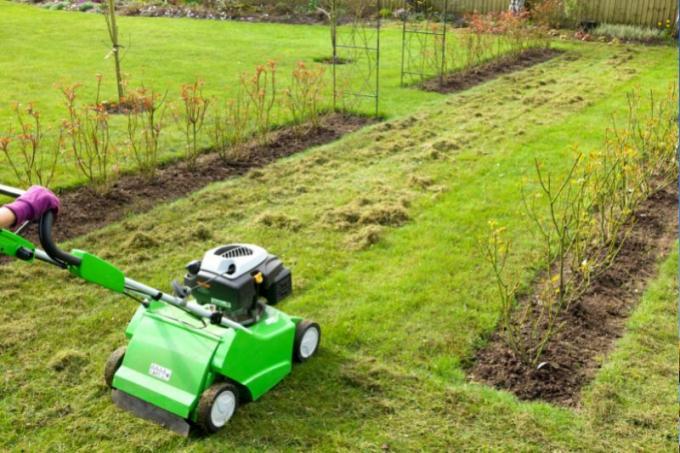
In order for your lawn to get through the winter well, you have to prepare it optimally. Here you can find out what measures can strengthen your green space so that it can survive the cold season. How to take care of your lawn in the fall.
cut the lawn
When the thermometer falls below ten degrees Celsius at night, you should Mow the lawn for the last time. Lawn stops growing at this temperature. You should therefore be careful not to cut it too short, otherwise the frost can penetrate the soil better and cause damage to the roots of the grass. In the case of utility lawns, it is advisable to shorten the grass to three to four centimetres. However, you should also not leave blades of grass that are too long, as they can break off in cold temperatures and damage the plant.

After mowing, remove the grass clippings. The low temperatures slow down the rotting process and the grass clippings would deprive the grass of light and air to breathe.
scarify
Autumn lawn care also includes scarifying. In autumn it is advisable to free the lawn from the existing layer of thatch. The best
Time for this is mid-September to mid-October. Only scarify your lawn when the thatch layer has reached a height of five millimeters. To do this, dig out a piece of lawn and see how high the felt layer is already. Caution: Is the scarifier Set too deep, it can damage existing roots.
The following is at scarify to note:
- Choose a dry day for scarifying
- Scarifier blades do not go more than two to three millimeters into the ground
- After scarifying, remove thatch from the lawn with a rake
Fertilize
For lawn care in autumn, you should not do without fertilizing. In autumn in particular, it is important to prepare the grass for winter and the associated drop in temperature with the right fertilizer. You should remember that fertilizing your lawn regard:
- use fertilizers containing potassium
- Choose a rainy day for fertilizing
- Mow and scarify the lawn beforehand
- Distribute fertilizer evenly using a spreader
- Apply 30 to 40 grams of fertilizer per square meter

The potassium-rich fertilizer ensures that the plant cells become stronger, making grass more resilient to cold and frost. Special autumn fertilizers also have a high iron content, which strengthens the lawn and prevents moss infestation.
Fix bare patches in the lawn
Autumn is the best time to oversee the lawn. The following reasons speak for this:
- Floor still warm from summer
- increasing rainfall allows seeds to germinate well

With this step-by-step guide touch up bare patches in the lawn:
- Loosen the soil on the bald spots.
- Remove weeds and other plant debris.
- Then apply lawn seed.
- Roll the spots down a bit so that the seeds get the necessary ground contact for germination.
- Keep the lawn seed sites consistently moist for at least four weeks for germination.
water the lawn
Statistically, September is now one of the dry months of the year. Therefore, depending on the weather, you should still water your lawn at the beginning of autumn or bust. Due to the moisture, the grasses can absorb the nutrients better and are therefore stronger for the winter. Stop watering when the first ground dew forms.

Protect lawns from fungal disease
With high humidity and low temperatures, snow mold tends to appear as early as September. This is one fungal disease, which manifests itself in the form of brown spots on their lawn.
How to protect your lawn from fungal diseases:
- use potassium-rich fertilizers to strengthen the grasses
- regularly remove damp leaves from the lawn
- Pick up fallen fruit
You can use the picked leaves as a mulch layer under rhododendrons or on beds.



